Yesterday I had a chance to have another run at General de Brigade rules and the Eckmuhl scenario L. and I played couple of months ago. For details about the scenario itself have a look at my first AAR.
Preparations and deployment
This time around, I’ve made slight changes to the terrain layout – I added one hex row to the width of the “battlefield”, thus increasing the distance between the villages. To add a bit of variety to the scenario and break up LOS (Scenarios in GdeB scenario books from Partizan are notorious in this respect with maps providing information only about prominent terrain features), I’ve randomly scattered clumps of heavy vegetation all over the place. The other addition, plowed fields, are there for purely aesthetic purposes.
Once again, it became my responsibility to lead the French to victory. Remembering lessons learned from the first game, this time around I decided to stick with the KISS-principle – I decided to commit my line infantry brigades to a brute frontal assault, one brigade each against the two villages. The remaining brigade (consisting of two battalions elite light infantry) would this time around be ordered to move as quickly as possible on my right flank and pin the enemy on the high ground behind the settlements, thus hopefully disturbing any counter-attacks before I took control of the settlements. Finally, I deployed my single battery in the middle, between my line infantry brigades, with intention of causing as much mayhem as possible among Austrian infantry deployed between the villages.
Austrian deployment in this scenario is rather hamstrung by deployment instructions – each of the villages must be garrisoned by a brigade, while the remainder of the troops is to be placed on the high ground behind them. The one significant change in L’s initial dispositions when compared with previous our game consisted of his decision to properly garrison the villages themselves. He placed one line infantry battalion in each of them and deployed rest of two brigades in his first defensive line between the settlements, thus securing the flanks of his defensive position. Remaining infantry was deployed on the heights behind, as per scenario instructions.
The game – day one
Yes, you read correctly – day one, since we had to split this “little” engagement over two days and at the moment this text is being written, the battle is still very much undecided and hanging in balance!
We managed to get through seven rounds during first sitting. The game developed in rather predictable fashion. During initial phases the French advance was pretty much undisturbed, if one disregards the fire from lone Austrian battery in the middle of L’s line. As my light brigade came into range, the other Austrian battery joined the fight and drew their first blood.
Pace picked up as my troops came near the village. By that time, L. got his Cheval-Légere regiment into position where they would become a major disturbance on my left flank. Their first action was to chase away my skirmish screen. That pushy behaviour was rewarded by a rather devastating salvo from outermost French infantry battalion, but that didn’t chase them away for long. Once they turned around, they parked themselves on the outer flank of troops in Oberlachning, effectively hindering one of my battalions from storming the village (GdeB rules hinder charges of any kind within half charge range of an enemy cavalry unit). I decided to wait for a turn – a decision that turned out to be horrific. In one of the last actions of the day, L now boldly ordered a charge against the my line battalion, still formed in column and too close to their assailants to form square. It was a close fight, but in the end my column was pushed back and retreated, with one third of its soldiers laying dead or wounded on the ground. The only reason why the engagement didn’t turn into complete disaster was that L.’s Cheval-Légeres blew their horses in the charge and had to retreat and reform behind their lines.
Assault against Unterlachning developed according to the French script. Once in range, two battalions of 57e Ligne charged into the village in a bold bayonet charge, swiftly ejecting its Austrian defenders. Or at least that was my intention, ‘cause in fact, only one of French battalions went in, the other deciding to sit this one out in last second (failed morale check before charge). Fortunately, that was enough and Le Terrible 57e managed to keep its reputation intact.
In the meantime, a vicious little fight developed between my light brigade and artillery on the heights behind the village. Frenchmen, in open formation, kept the battery under fire, but they paid the price. At this time, that engagement is still undecided.
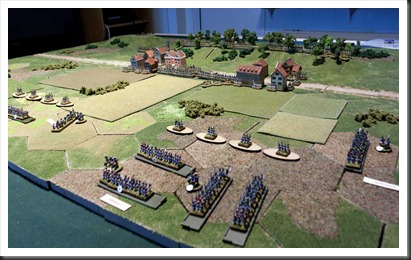
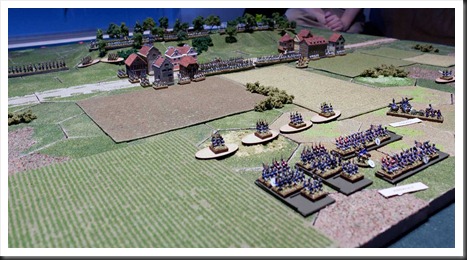
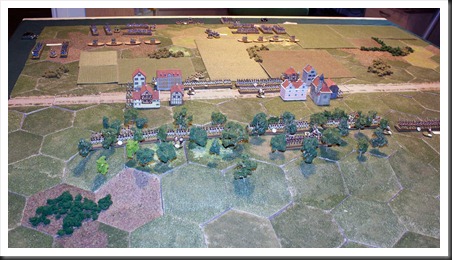
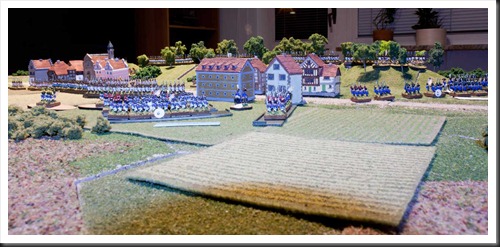
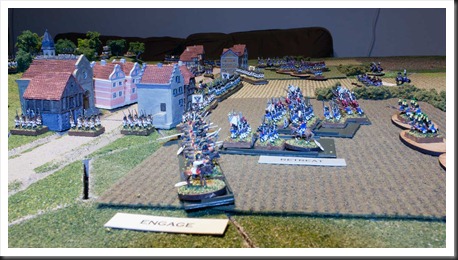
Press on mon ami! I our GdB games I have suffered cavalry charges in line, column, and square and I can assure you that forming square is the only solution to keep horsemen at bay. There is some chance to form square if the cavalry is charging from more than half of its charge range (page 69 in my GdB Deluxe book)but I have not been very fortunate in relying on that rule either.
ReplyDeleteI look forward to reading about the rest of the battle.
Thanks for the kind words, James. In case of that particular charge, it was my full intention to change formation to square, but you know what they say about humans making plans. The gods certainly had a good laugh when they decided that there would be HALF a centimeter less than necessary for me to be able to attempt that maneuver (half charge distance for light cav is 9.5cm, there was 9cm between hapless French and Austrian cheval-légeres). Still, it was a close call, I lost with one pip and I thought I did pretty well until I discovered that GdeB is not kind to infantry loosing a charge against cavalry, no matter how close the victory margin was.
ReplyDelete